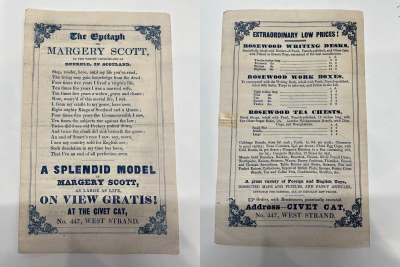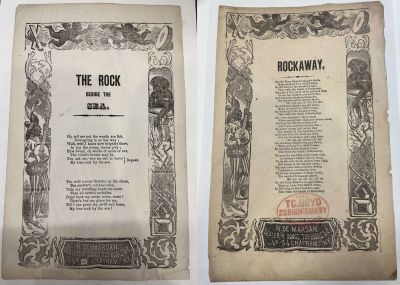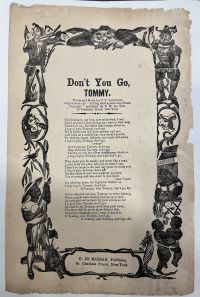American and British Ballads, Circa 18th-19th Centuries

Broadside ballads are unbound single folio sheets of paper (called broadsides) that feature a ballad, poem, or rhyme that is meant to be sung to a traditional folk tune. Broadside ballads were often decorated by generic woodcuts that were widely applicable. These wooducts utilized relief printing, where the raised surface of the woodcut was used to print the image. Due to their inexpensive production cost, ease of production, and simplicity of dispersal, broadside ballads developed an ephemeral nature wherever they were disseminated. They initially rose to popularity in the United Kingdom, but eventually became staples of popular culture in Ireland and the United States as well. Broadside ballads are often integral components of research into the development of early popular culture and the influence of technological innovations on culture.
The collection of broadside ballads entitled American and British ballads, circa 18th-19th centuries, located in the University of Pennsylvania's Kislak Center for Special Collections, Rare Books and Manuscripts, houses many of the University of Pennsylvania’s collected broadside ballads. The ballads in this collection are preserved in individual folders, typically originating from the late 18th to late 19th centuries. Of the ballads in this collection that indicate their publisher, the majority come from either London, New York City, or Philadelphia.
The Collection
The broadside ballads in this collection vary significantly in not only content, but also physical characteristics. The content in this collection spans love, drinking songs, extreme weather events, the struggles of labor, journeys, and historic poems. The inexpensive paper used for these ballads has started to experience discoloration in many cases, sometimes adopting a brownish hue, denoting significant oxidation over time. Although the physical dimensions of each different ballad varied significantly in both size and proportions, all of them took up only a fraction of the size of a contemporary letter paper of 8.5 x 11 inches. In terms of text, broadside ballads are known for their persistence in using black-letter type long after roman type became the standard.[1] However, most of the ballads in this collection use roman type, which can be attributed to the fact that most of them were published in the latter half of the 19th century, an era where black-letter type was phased out even more.
Ownership
The history of the ballads in this collection was not documented by the university. It is unknown when each individual ballad was collected, who designed the collection, who previously owned the ballads, or when the collection made its way into the Kislak Center for Special Collections, Rare Books and Manuscripts.
There are very few traces of ownership of these ballads. Although some are ripped and feature spills and stains, the majority of them appear to be intentionally preserved, as they do not have any marks, marginalia, annotations, folds, or creases. This preservation is not what would typically be expected of a broadside passed out at a tavern for entertainment purposes. It is therefore reasonable to assume that publishers often held onto a few copies of each ballad, and that these eventually made their way into different ownership. It is also highly likely that individuals specifically collected broadside ballads, as many featured layered conservation. These conserved ballads had an additional larger sheet of high quality paper attached to the back of them. However, a few had a red stamp reading “From T.C. Boyd 228 Montgomery San Francisco”, including the ballad entitled Rockaway, which may have been a collector of broadside ballads.
Usage
Circulation
Broadside ballads were primarily sold by publishers and booksellers as a form of revenue. Several factors led to the astonishing extent to which broadside ballads were circulated. Primarily, the large-scale production of broadside ballads was enabled by the development of the printing press, which made it possible to generate hundreds of copies of the same ballad at a time. These were then passed out at gathering spots, including fairs, markets, and taverns, sometimes being sold for as little as a single cent.[2]

The circulation of stories through broadside ballads also resembles the circulation of information through oral tradition. For example, ‘ballad mongers’, would often take lyrics from performers throughout their city and directly use them in the broadside ballads that they would then sell for profit.[3] In the likely scenario where lyrics are not perfectly transcribed, the tradition of broadside ballads recapitulates the slight alterations that oral traditions accumulate over time. In addition, this further exemplifies the lack of licensing and licensing enforcement during the era of the broadside ballad, despite licensing laws being established.
Audience
Broadside ballads were intended for communal entertainment; at their peak, it was not uncommon to hear groups of people singing them in taverns, at work, in the streets of cities, or even in the fields of farms.[4] They were intended for broad audiences and typically did not delve into niche topics or interests, as a more general target demographic optimized revenue for printers. Since broadside ballads were often sold at taverns and alehouses, it can be assumed that they were more geared towards adults.
Secondary Utility
Although the majority of ballads in this collection were simply single-sided with the sole purpose of providing words for a tune, a small proportion of them had content on both sides. The ballad entitled The Epitaph of Margery Scott features an advertisement on the back for writing desks, work boxes, and tea chests, all made out of rosewood, among other items. It was not uncommon for ballads during this era to feature handbills, advertisements, and brief newsletters on the back.[5] The incorporation of advertisements into broadside ballads reflects the growing relationship between entertainment and strategies to boost revenues of that era. Incorporating advertisements into popular culture not only allowed sellers to boost sales, but also allowed for publishers to gain an additional stream of revenue for the same product. The modern style of fusion of advertisement into entertainment, which started with newspapers and ballads such as those of the 18th century, can be seen as a precursor to contemporary advertisements on television and in social media.
Authorship

Broadside ballads provide a unique view into authorship, copyright, and accreditation in early popular culture. Despite the origin of ballads ranging from newly composed works to century old poems and old stories passed down from oral tradition, authorship was rarely credited. Most ballads in the collection did not state the origins of the written works, with no copyright or licensing. In the ballads that explicitly stated the tunes that the text should be sung to, these often went uncredited as well. This may be unexpected to some as a result of the establishment and strength of copyright laws by the late 19th century, but this simply reflects the nature of folk traditions. Many folk songs, stories, and rhymes are passed down orally across generations without accreditation.
However, some of the ballads in this collection do show accreditation, albeit vague. For example, the ballad entitled Ancient Rams No. 2 of Southwark, which was published by Thomas M. Scroggy, credits “T. K.” as the author. In another ballad from Thomas M. Scroggy, entitled The Bed-Bugs’ Song, the author is cited as T. M. Scroggy, a clear example of a newly composed work. This demonstrates a diversity in both authorship and recency of composition of the works.
Minstrelsy

After their initial conception, broadside ballads developed further by the influence of minstrelsy in both the United Kingdom and United States in the 18th and 19th centuries.[6] Minstrel shows featured white actors portraying African-Americans through the use of blackface in theatrical performances of skits, dancing, and music. In these performances, African-Americans were portrayed with comically exaggerated stereotypes that were meant to mock intelligence and abilities. These degrading portrayals from the minstrel show then bled into broadside ballads, which adopted the same caricatures and stereotypes in the form of woodcuts. Many ballads featured vulgar and demeaning woodcuts of African-Americans in the same style as seen in the minstrel show, and these depictions in the woodcuts were present irrespective of the content of the ballad's text. For example, the publisher H. De Marsan would reuse the same woodcut with demeaning depictions of African-Americans on several, unrelated ballads. Within the social context of the 19th century, this demonstrates the highly racialized nature of popular culture and entertainment in a racially stratified society. With racial prejudice commonplace, publishers continued the culture of the minstrel show with the belief that it could boost sales and overall success of the company. It further provides context into the readership of broadside ballads, as they were likely targeted towards a white audience.
Influence
The ballads in this collection exemplify several manners by which broadside ballads influenced the culture of the United States and United Kingdom outside of merely providing entertainment. For instance, several of them utilize tunes of folk songs to describe historical tales. The ballad entitled The Epitaph of Margery Scott utilizes the text of a historic poem that symbolizes Scottish pride, which delineates how broadside ballads could also secondarily instill values into their readers, such as that of national pride.

Some ballads in this collection additionally featured light engagement into news and politics. This ranged from descriptions of extreme weather events to the hardships of work life. These likely influenced the public by not only keeping them educated about current events, but also may have shaped public opinion on certain political issues. In 17th century English ballads, researchers have identified a rise of political engagement in broadside ballads during decades of economic and political crises.[7] This further exemplifies the ability of publishers to influence public opinion on specific issues as a result of how easy the dissemination of ballads was.
Broadside ballads provide a unique perspective into the qualities that make a type of media influential in popular culture. Although a piece of media needs quality content to be relevant and influential, the historical lens provided by studying broadside ballads makes it clear how developments in technology can catalyze changes in a society. Broadside ballads cultivated a shared culture that was spearheaded by easy printing. The physical print job did not even need to be of a pristine quality, as several ballads had misprints. The ballad entitled Don't You Go, Tommy had a clear misprint of the minstrel image as the woodcut was laid over a second time, not lining up with the initial print. The ability to mass produce a cheap, useful product, even if it was of an ephemeral nature, allowed that product to have a monumental influence on the local culture. Broadside ballads managed to influence the preservation of folk stories, cultivate a shared culture through entertainment, and lay the groundwork for popular music. All of this was possible due to the developing printing technologies of the time, in addition to efficiency of this technology, exemplifying how the form of a 'book' can play a massive role in their popularity. Even though the ballads of the early modern United States and United Kingdom were shaped by the popular culture of their time, the reciprocal relationship they had with society by shaping the shared culture of its readers is what truly made them extraordinary.
Citations
- ↑ Nebeker, E. (2007). The Heyday of the Broadside Ballad. UCSB English Broadside Ballad Archive. Retrieved May 3, 2023, from https://ebba.english.ucsb.edu/page/heyday-of-the-broadside-ballad
- ↑ McAbee, K., & Murphy , J. C. (2007). Ballad Creation and Circulation: Congers and Mongers. UCSB English Broadside Ballad Archive. Retrieved May 3, 2023, from https://ebba.english.ucsb.edu/page/ballad-creation--circulation
- ↑ David Gregory (2016) Street Ballads in Nineteenth-Century Britain, Ireland, and North America: The Interface between Print and Oral Traditions, Folk Life, 54:1, 70-72, DOI: 10.1080/04308778.2016.1159785
- ↑ Nebeker, E. (2007). The Heyday of the Broadside Ballad. UCSB English Broadside Ballad Archive. Retrieved May 3, 2023, from https://ebba.english.ucsb.edu/page/heyday-of-the-broadside-ballad
- ↑ Penn Libraries. (n.d.). American and British ballads, circa 18th-19th centuries. Retrieved May 3, 2023, from https://franklin.library.upenn.edu/catalog/FRANKLIN_9974043083503681
- ↑ Fowler, D. C. (1968). A literary history of the popular ballad. Duke University Press.
- ↑ Nebeker, E. (2011). The Broadside Ballad and Textual Publics. Studies in English Literature, 1500-1900, 51(1), 1–19. http://www.jstor.org/stable/23028090